Acer Aspire V3-571G-9435: The Value Proposition
by Jarred Walton on July 4, 2012 4:25 AM ESTAcer V3-571G Gaming Performance
Next up in our test suite are our gaming tests, which we discussed in our 2012 Mobile Benchmark Matrix. We conducted all of the 1366x768 testing with the internal LCD and connected an external 1080p display for the Mainstream and Enthusiast test results. Our Value settings are generally very easy on the V3-571G while the Mainstream settings can sometimes be a bit much and the Enthusiast settings (shown in Mobile Bench) are typically beyond the capabilities of the GT 640M. One of the disappointing decisions Acer made with this laptop is the choice to go with slightly cheaper DDR3 memory for the GPU; while GDDR5 isn’t as necessary at the native LCD resolution, it certainly would have helped with gaming on an external LCD. Of course, we would have liked both GDDR5 and a better LCD, but we tend to be greedy.
Value Gaming Results
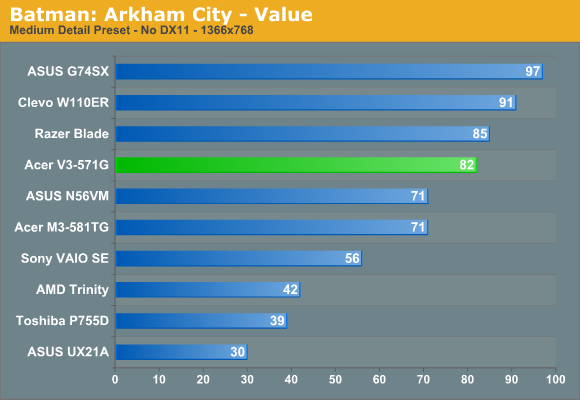
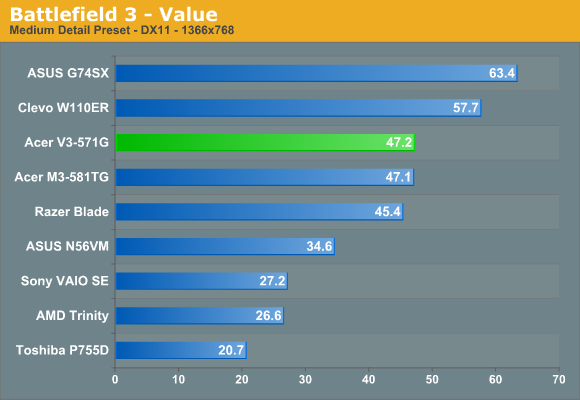
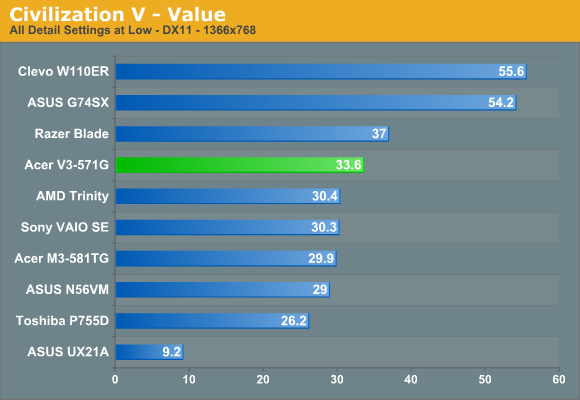
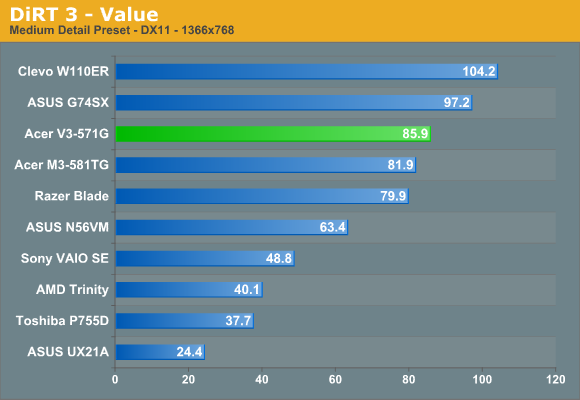

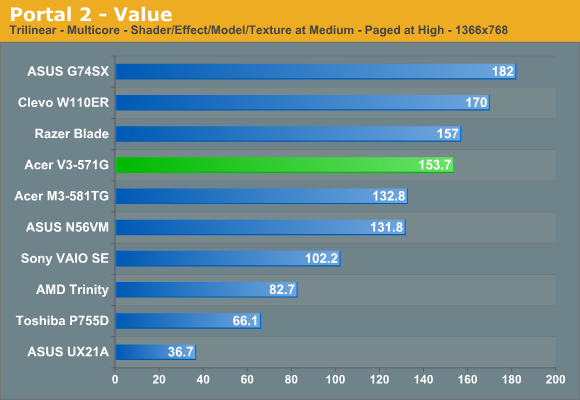
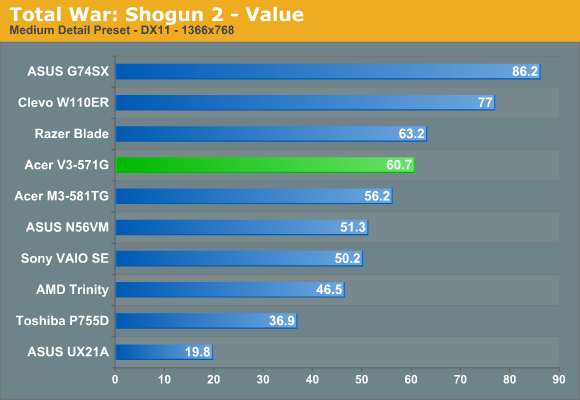
We won’t say too much about our Value settings, other than the V3-571G is more than capable of running all the test games at these settings without difficulty. Civilization V was initially the odd man out, with performance coming in just shy of 30FPS at 28.3; however, the just-released-yesterday 304.79 beta drivers have improved Civ5 performance by around 15%, pushing Civ5 up to 33.4FPS. I still feel it’s possible the current NVIDIA drivers aren’t optimized very well for mobile Kepler, but how much more performance they can eke out with driver updates remains to be seen. The previous generation GT 555M in the Razer Blade is still 10% faster than the GT 640M, and AMD’s A10 Trinity chip is nipping at the heels of what should otherwise be a much faster GPU. The GT 650M in the W110ER also comes in a whopping 65% faster (with a core clock that’s only 18% higher), so something is certainly odd with the current Civ5 results. The V3 breaks 60FPS in nearly all of the other games, Battlefield 3 being the other exception (though at 47FPS it’s certainly fast enough for multiplayer gaming).
Note that in all of these games, the Clevo W110ER with the faster clocked GT 650M (but still with 2GB DDR3) easily outperforms the GT 640M, suggesting that at least for our Value settings memory bandwidth isn’t a bottleneck. The GT 555M GDDR5 on the other hand trades blows with the GT 640M, winning several matchups but falling slightly behind in others. In terms of compute power, the GT 640M should win out by roughly 20%, but the GDDR5 memory gives the GT 555M nearly 40% more bandwidth, with the result being a pretty even fight. Let’s see what happens at our more demanding Mainstream settings.
Mainstream Gaming Results
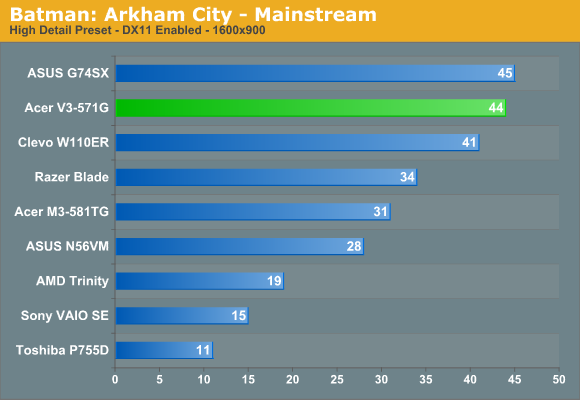
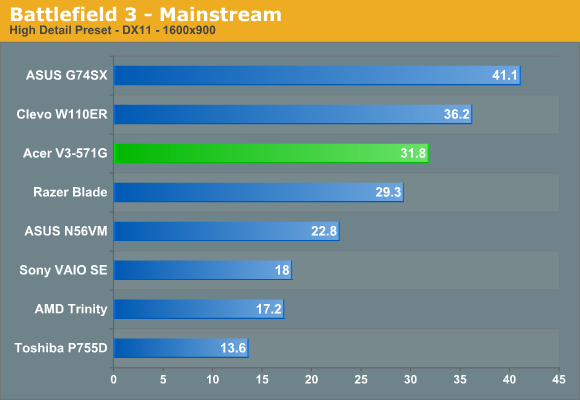

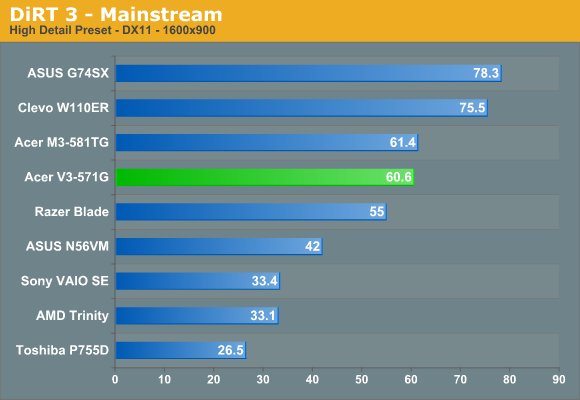

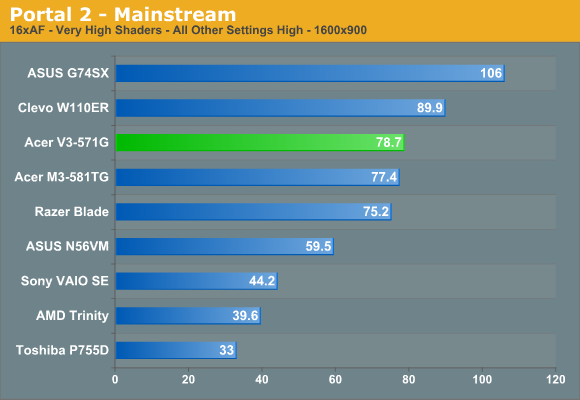
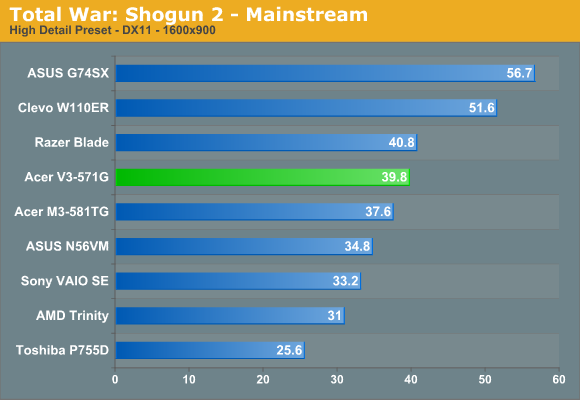
With the increase in detail levels and resolution, performance drops are pretty significant. The V3-571G manages to stay above 30FPS in all of the titles, with the exception of Civilization V, but frame rates are low enough in BF3 that we’d recommend using lower settings for multiplayer. The Razer Blade likewise continues to trade blows with the V3, indicating we’re still pretty balanced between memory and shader requirements. Of course, outside of gaming on an external display, no one would actually be running at our 900p Mainstream or 1080p Enthusiast settings, so we put together another table with our recommended settings and the performance you can expect.
Recommended Gaming Settings and Performance
|
Acer V3-571G-9435 Gaming Recommended Settings for 1366x768 |
|||
| Detail | FPS | Notes | |
| Batman: Arkham City |
Very High + Normal PhysX + High FXAA |
34 | You can run either DX11 or PhysX at decent frame rates with the GT 640M, but PhysX in my opinion looks better than DX11. FXAA is basically "free". |
| Battlefield 3 | Ultra + 1xAA | 37.8 | Single-player is fine at these settings, but multi-player might need to drop down to high or even medium settings. |
| Civilization V | Low (“Value”) | 33.4 | Unless NVIDIA can further improve Civ5 performance with a driver update, stick with our “Value” settings (though you could turn up a few knobs). |
| DiRT 3 | Ultra + 4xAA | 32.4 | If you’re a stickler for maintaining >30FPS frame rates, you should probably disable AA. |
| Portal 2 | Max + 4xAA | 79.3 | Portal 2 is one game in our suite where you can basically max out all settings without any concern for performance. Have fun! |
| Skyrim | Ultra + 4xAA | 34.9 | Skyrim also plays quite well at the Ultra defaults, though we recommend setting AA to 4xAA instead of 8xAA. |
| Total War: Shogun 2 | Very High | 38.5 | Maximum detail works fine for this game, though you may need to edit the INI file to specify VRAM in order for the Very High preset to unlock. |
Most of the games in our test suite run fine at close to maximum detail at the LCD’s native resolution. You can read our testing notes from above, and the only games that need lowered settings are BF3 and Civ5 (surprise). I also ran a test of Diablo 3 (Nightmare difficulty, midway through Act 1) and found that even 1080p at maxed out settings (with the newly added “High (Smooth)” shadowing enabled) was playable on an external LCD, with an average frame rate of 38FPS over 30 minutes. During that period, there were only four dips below 20FPS, with frame rates staying above 30FPS 91% of the time and above 25FPS 99.5% of the time. Of course, if you play on the integrated laptop display you won’t have any issues with frame rates whatsoever. [Ed: Battle.net lag on the other hand….]
The short summary of the gaming results is that the V3-571G definitely has sufficient performance for running any modern game, though not always at max quality. If you prefer gaming performance put into perspective, today’s mainstream GT 640M is generally faster than the GTX 285M from a couple years back, and it consumes less than half the power. It’s also a pretty good match up against the Radeon Mobility HD 5850 and GTX 460M—again, while using substantially less power. With GDDR5 memory, the GT 640M would likely outperform both of those cards.










88 Comments
View All Comments
weiran - Wednesday, July 4, 2012 - link
Terrible display ruins a laptop.You should refuse to review 15" laptops with a resolution more suited for an 11".
JarredWalton - Wednesday, July 4, 2012 - link
If we refused to review any laptop with a marginal display, we'd be stuck with about 10 to 15 laptop reviews per year -- and that's assuming we could even get all the good display laptops in for review. We would also forego reviews of any laptop that doesn't cost at least $1000. Needless to say, the volume of laptops sold for under $800 is probably an order of magnitude more than the volume of over $1000 laptops sold, so it's an important market to at least look at.duploxxx - Wednesday, July 4, 2012 - link
no one in this budget needs that quad core horse power. Acer would be better of spending the wasted money on build quality or better screen.Penti - Wednesday, July 4, 2012 - link
On the other hand GT 640M wouldn't drive a high-res screen at native resolution. In games that is. But I'm quiet appalled that we can have chassis like this in the Ultrabook and starting configurations for business notebooks price range. Even if you don't have the best displays, or the budget to do all like a super nice case you should at least have a good touchpad and keyboard. Something like a Acer TimelineU M5 wouldn't be more expensive either. So I'm note sure what they are thinking it looks to be a much better notebook, you don't need quadcore notebooks for gaming, the trackpad looks to be better (if they don't fail at it, looks to be a cheap variant on the V3 though) at the M5 and it also comes in a 14" variant.A 2kg dualcore notebook for 800 with GT 640M should be well enough here, and does look better then this. But you loose 1GB of VRAM as well as that quadcore. Yet this doesn't look like a 800 dollar notebook from today and I think it's time to leave the plastic gamer ~800-1000 dollar notebooks behind and let compal and Clevo come up with better computers to fill that need for the OEM's or for them to take the market more seriously and design something decent themselves. Mobile gpus for mid-end performance for gaming obviously exist for half decent power and price range. I thought Acer was trying to clean up their act and please kill all the packard and gateway branding too. Those might have filled up a space in the early 90's, but it's not something you like to remember. Lots of similar stuff isn't the right thing here, if you still like to have budget lineups they will need to be more differentiated from high end models. They should still be decent enough for those that don't like to spend 800-1000 or more too.
JarredWalton - Wednesday, July 4, 2012 - link
Statements like this are so arrogant. "No one in this budget needs that quad core CPU." Really? Who made you the determiner of what every person needs? I know a lot of poor college and high school students that would like to be able to have access to more than just basic dual-core processors. Following your logic, we end up back with the old "640K should be enough for anything" mentality of the DOS era. While most people don't need and won't use the processing power of a quad-core CPU, to say that no one needs it is very narrow minded.bupkus - Wednesday, July 4, 2012 - link
I know a lot of poor college and high school students that would like to be able to have access to more than just basic dual-core processors.Good, but the question is, "can they afford it"?
We have promised to buy a nephew a notebook and had anticipated to pay no more than $500. Now I'm wondering what we can get that will allow this high school grad to do school work and just not even try to provide him gaming or media capabilities.
For that purpose a good monitor seems more significant than an i7 processor. We hope we can find just such a notebook with perhaps a dual core Sandy Bridge processor and even a decent keyboard. Intel HD 3000 display will do just fine. Only the resolution needs a little upgrade.
JarredWalton - Wednesday, July 4, 2012 - link
Obviously there's no single answer to what's most important, but For many of the components, whatever you buy with your laptop is going to be what you're stuck with until you buy a new laptop. If you buy a laptop that doesn't have a discrete GPU, it will generally be inadequate for gaming. You have a better chance of upgrading the display (see the LCD testing section where I discuss what's required) than you have of adding a discrete GPU to a laptop that doesn't come with one. Even swapping out CPUs can be a bit tricky, as you have the potential for locked down BIOS firmware that refuses to support anything besides a couple specific CPUs.Anyway, while I understand that many parents might find the lack of graphics hardware a benefit, if your son/daughter/nephew/niece/etc. ends up not liking the laptop and taking out a student loan to go buy a laptop that they do want, you've wasted money. This definitely happens, as I knew quite a few people back when I was in school that spent $1500+ from their student loans on a new PC that they "needed" for their studies. Of course, I was a CS major so they really did need a computer of some form, but I'm not so sure the 3dfx Voodoo cards were required hardware....
jabber - Wednesday, July 4, 2012 - link
True, however, if you keep reviewing these inferior screens then they will still keep coming.If you said to the manufacturers "No sorry but we consider that spec to be obsolete/inferior to what our users want to buy!" then the message may get across that things have to change.
If you only review 15 laptops a year so what? They are more likely to be ones your readers want to buy after all.
Plenty of other stuff to review than crappy screened laptops after all.
retrospooty - Wednesday, July 4, 2012 - link
"True, however, if you keep reviewing these inferior screens then they will still keep coming. If you said to the manufacturers "No sorry but we consider that spec to be obsolete/inferior to what our users want to buy!" then the message may get across that things have to change"I agree in theory, but the root cause is the issue. Having a site or two or several say that wont change anything. Manufacturers will keep making it as long as people keep buying it.
At least today there are alot more 1600x900 and 1920x1080 options in 13,14 and 15 inch laptops than there has been for the past 3 years. It's starting to shift to higher res.
JarredWalton - Wednesday, July 4, 2012 - link
Exactly. I love how I'm supposed to refuse to review laptops that 90% of people I know outside of AnandTech will buy, and in turn only review hardware that 10% or less of people I know will use. And AnandTech should apparently also only cater to the enthusiasts, rather than trying to build our audience.Articles like this can get noticed by the semi-technical readers that are researching a laptop, and they might end up saying, "Wow, there's a ton of information in that review that I can't find elsewhere. If they think this laptop is fast but cheap -- in price as well as quality -- what do they recommend as an alternative? Maybe I should read more...." We have the potential to increase knowledge as well as readership with mainstream articles like this.
It's always important to see what's going on in the budget oriented market segment when evaluating higher end offerings. I should have a few higher quality (and higher price) laptops in for review shortly, some with good/great screens and some with more of this 1366x768 nonsense.